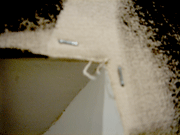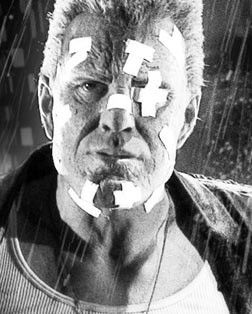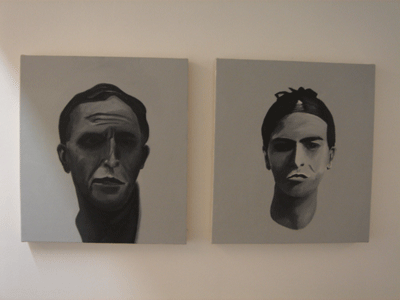January 22, 2007
Sin City
When I told Phil how I would title this blogpost, a big smile came to his face. For a young man, Phil has a grizzled face. Smiles for him don't come cheap. He was the first to tell me about Netflix when I returned from Spain last year and he recommended the first movie I should rent, something called Sin City. Phil was sleeping off the all nighter installation of his show at Black Dragon Society. In record time, he installed two big paintings and a kind of mural on the back wall facing the entrance.
I mentioned the comparison to David Salle's painting (the thoughts of writer Michael Ned Holte, as we were talking the other day), about Phil's use of the floating superpostition of images. I mentioned Rosenquist and Phil was fast on the association, weighting the latter more than the former. I thought of his F-111 and the big show of his I saw in Houston.. The immersion and (institutional) scale is a dizzy direction to look into.

I noted the back wall install and I asked why he (Phil) didn't turn the corner when his canvas came to the door and window openings. Is it possible that for you architecture is another name for painting's support? Was gypsum/wood/stucco equivalent to stretcher bars? And if painting was immersive, was he thinking in terms of the 1998 movie "What Dreams May Come", where the audience was intended to enjoy a literal insertion into paint? But by not turning the corner, Phil stopped short of architecture. According to him, its purpose was to set a stage for the other two paintings in the show.
A stage.
Was mood setting this important?
Yes.
What was the mood, I wondered?
Dark. Brooding. Noir.

Sin City.
Frank Miller's Sin City. No wonder it was Phil's first movie recommendation for me. Phil is Marv. Even the interior of Phil's studio can best be described by Marv's image: holes punched into the walls, rough patches covering them, cheap office carpeting soaked in paint and glue, heaps of spent art materials piled in drifts in the corners... I cut and paste a section of the Wikipedia description for effect::
...Despite his presumed Catholic upbringing, Marv is a violent, borderline psychotic who uses his tremendous strength and fighting skills to bring down those who challenge him or break his personal code of ethics.He suffers from an unnamed mental condition that causes him to "get confused", which, judging from his own awareness of his illness and the effects it is shown to have, probably involves short-term memory loss and possibly hallucinations. Lucille, his parole officer, supplies him with medication to control these effects of his condition. Lucille's girlfriend Claire, a psychiatrist, supplies Marv's drugs and once tried to analyze him, but he claims she got "too scared." He doesn't seem to be supplied with anything that curbs his violent impulses, however.
Marv is convinced that he is not that smart, but he shows a surprising amount of intelligence when needed, noticeably an ability to logically deduce confusing and complex events. However, in most situations he just smashes his way through conflicts, such as kicking down a door and sending police flying, or charging a squad of heavily armed cops whilst only armed with a hatchet.
Marv has a well developed skill and appetite for torture; he never blinks or seems to think twice about inflicting upon his worst enemies the slowest, most painful death he can possibly implement. He speaks in a soft, calm manner, showing no sign of hesitation or fear, even while committing gruesome killings.
While he has no compunction about maiming and killing anyone he feels has wronged him, even he has his limits. He is deeply afraid of winding up as "a maniac [or] a psycho killer" and thus will only kill someone if he "knows for sure he ought to", making it a point to not kill those who have not earned it. He adheres unrelentingly to his own personal code of honor, which also dictates the repayment of debts and chivalry towards women. He may also have a soft spot for children
(This comparison is not a literal one, a reminder for the literally minded.)
Through the portal that leads to the backroom, one can see two portraits of Phillip Guston and Frida Kahlo. In them, I see ramifications of Phil's dark and hard superpositions. The faces of these two icons are rendered in the way the police use facial composite systems in (I'm thinking in terms of the transparent plastic of ye olde days) overlays. Outside of the brawny scale and Pop references, the somber slip of the facial components reveals some kind of hard grey monochrome (Richter's early work comes to mind now) where visual tropes float fitfully overhead.

Leave a comment